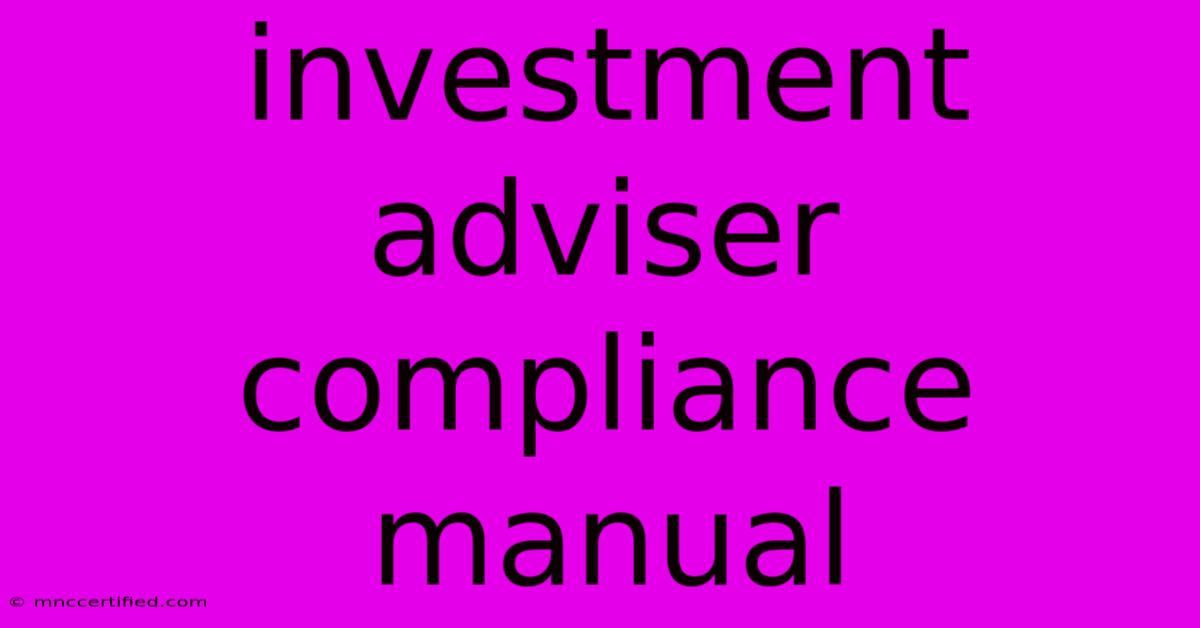Investment Adviser Compliance Manual

Table of Contents
Navigating the Labyrinth: An Investment Advisor Compliance Manual Guide
The world of investment advising is complex and highly regulated. Ensuring you're in compliance with all applicable laws and regulations is essential for your firm's longevity and success. That's where an investment advisor compliance manual comes in.
This crucial document outlines your firm's policies, procedures, and internal controls for complying with regulatory requirements. Think of it as your firm's rulebook for navigating the ever-changing landscape of investment advisory regulations.
Why is an Investment Advisor Compliance Manual So Important?
- Protection from Legal and Regulatory Trouble: A strong compliance manual acts as a shield against potential legal issues and regulatory sanctions. It demonstrates to regulators that you're committed to ethical practices and upholding the law.
- Building Client Trust: Clients want to work with advisors who are reliable and trustworthy. A well-defined compliance manual shows clients that you prioritize their interests and adhere to best practices.
- Promoting Internal Consistency: It provides clear guidance to your team on how to handle various scenarios and ensures consistent application of policies across your firm.
- Facilitating Audits: A comprehensive manual makes it easier for you and auditors to navigate your firm's compliance practices, ensuring a smooth audit process.
Key Components of an Effective Investment Advisor Compliance Manual:
1. Introduction and Overview:
- Purpose: Clearly state the purpose of the manual and its intended audience.
- Scope: Define the scope of the manual, including the specific regulations it covers and the types of investment advisory activities it applies to.
- Definitions: Provide definitions of key terms used throughout the manual.
2. Client Relationship and Information:
- Client Suitability: Outline your process for assessing client suitability, including risk tolerance, investment goals, and financial situation.
- Client Disclosure: Establish policies for providing clients with essential information about your firm, fees, and services.
- Privacy and Confidentiality: Implement robust policies to safeguard client information and maintain confidentiality.
3. Investment Management Policies:
- Investment Strategies: Define your firm's investment strategies, including risk management practices and portfolio construction methods.
- Trading Policies: Establish clear guidelines for trading activities, including order execution, conflict of interest avoidance, and best execution practices.
- Custody of Assets: Determine how client assets are held and who has access to them.
4. Compliance and Risk Management:
- Compliance Program: Describe your firm's compliance program, including the roles and responsibilities of compliance personnel.
- Risk Management: Outline your risk management practices, including identifying, assessing, and mitigating potential risks.
- Conflict of Interest Management: Establish policies for identifying and managing conflicts of interest.
5. Recordkeeping and Reporting:
- Record Retention: Define your firm's recordkeeping policies and the required retention period for various documents.
- Reporting Requirements: Outline your reporting requirements to clients, regulators, and other relevant parties.
6. Other Important Sections:
- Code of Ethics: Include a code of ethics that outlines your firm's ethical standards and expectations for employees.
- Compliance Training: Describe your training program for employees on compliance and regulatory issues.
- Accountability and Oversight: Establish procedures for reporting violations and ensuring accountability for compliance.
How to Create an Effective Investment Advisor Compliance Manual:
- Seek Professional Advice: Consult with an experienced compliance attorney or consultant who can help you tailor the manual to your firm's specific needs and regulatory environment.
- Stay Updated: Regularly review and update the manual to reflect changes in regulations, industry best practices, and your firm's operations.
- Involve Your Team: Engage your team members in the process of developing and reviewing the manual to ensure it's practical and relevant.
- Make it Accessible and Understandable: Use clear language, logical organization, and a user-friendly format to ensure the manual is easily accessible and understandable for all staff.
Building a strong investment advisor compliance manual is a critical step in protecting your firm, fostering client trust, and ensuring a successful and compliant business. By following these steps and implementing a comprehensive manual, you can navigate the complex world of investment advising with confidence and peace of mind.

Thank you for visiting our website wich cover about Investment Adviser Compliance Manual. We hope the information provided has been useful to you. Feel free to contact us if you have any questions or need further assistance. See you next time and dont miss to bookmark.
Featured Posts
-
Monday Sports Betting Dolphins Nhl College Basketball
Nov 12, 2024
-
Gary Lineker 7 Times He Spoke For The People
Nov 12, 2024
-
Dogecoin Investment Analysis 100 Todays Value
Nov 12, 2024
-
Yellowstone Season Premiere Fate Of John Dutton
Nov 12, 2024
-
Rep Stefanik Nominated For Un Ambassador
Nov 12, 2024